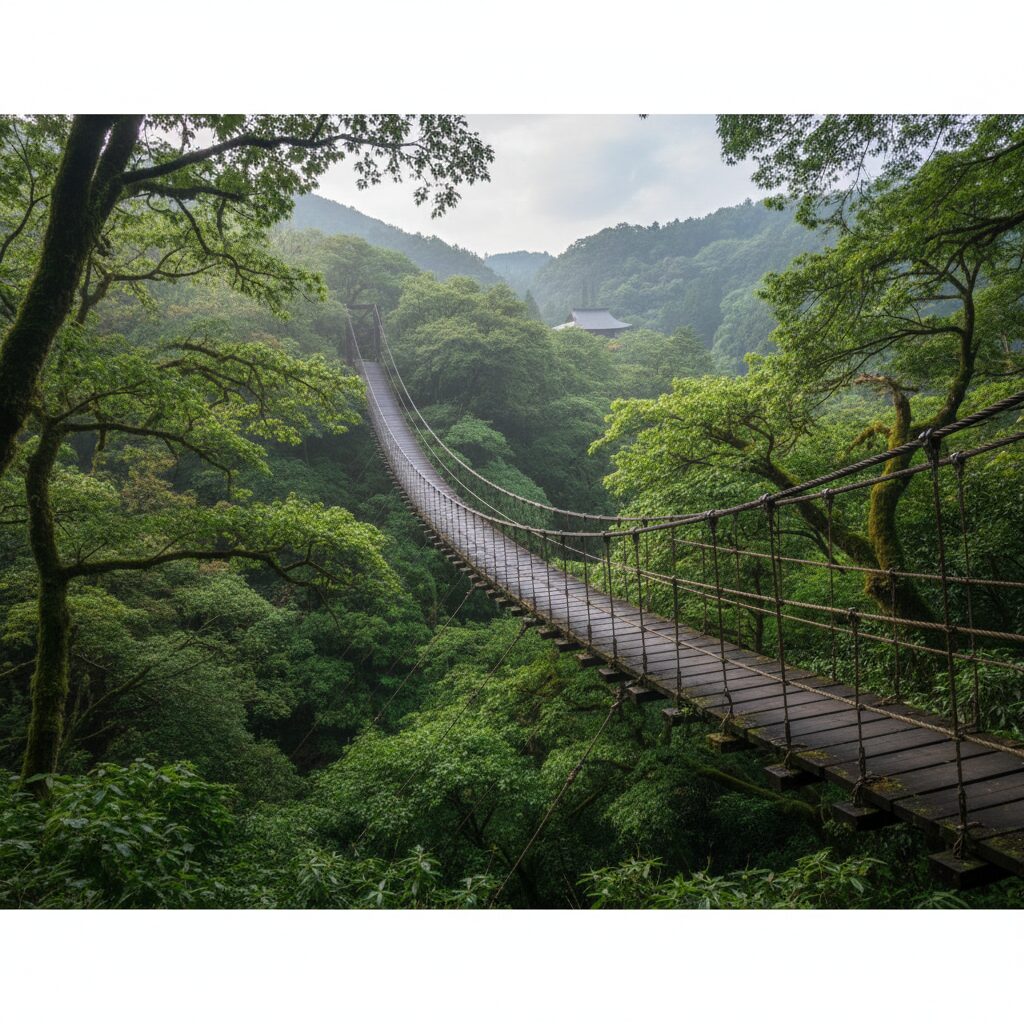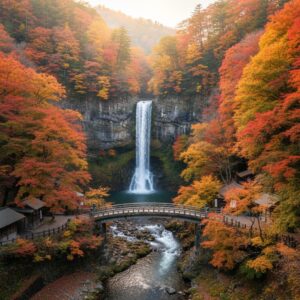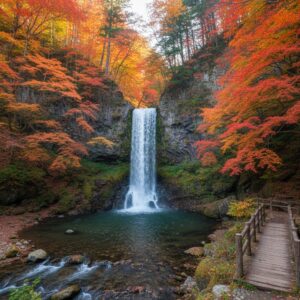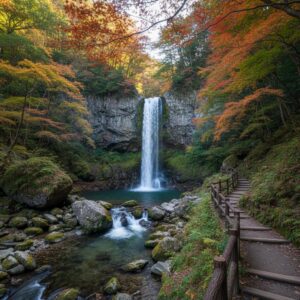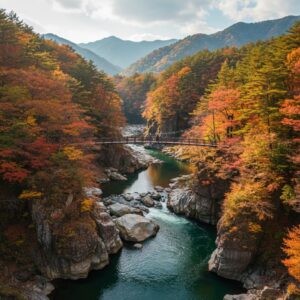Just beyond the electric pulse of Osaka’s neon-drenched streets, where the symphony of the city gives way to the whisper of the wind through ancient trees, lies a world suspended between earth and sky. This is Hoshida Enchi, a sprawling prefectural forest park, and its crown jewel is the Hoshi no Buranko, the ‘Star Swing’ suspension bridge. It’s more than just a destination; it’s a portal, a place where a simple train ride can transport you from the concrete canyons of one of Japan’s largest cities to a breathtaking panorama of untouched wilderness. For those who seek the thrill of adventure, the solace of nature, or simply a new perspective on the Kansai region, Hoshida Park offers an unforgettable journey. It’s a reminder that even in a land of bustling metropolises, wild, soul-stirring beauty is never far away. You just need to know which train to catch and which path to follow. This is the story of that path, a climb towards a bridge that doesn’t just span a valley but connects the urban soul to the heart of the forest.
The Departure: From Urban Rhythm to Forest Murmurs

The adventure doesn’t start at the trailhead, but on a Keihan line train platform as it pulls away from the familiar hum of Osaka. Departing from a busy hub like Kyobashi, the carriages reflect city life—a mix of students with headphones, businesspeople with briefcases, and shoppers carrying their day’s finds. Yet, as the train clacks its way eastward, a subtle change takes place. The dense array of buildings starts to thin, interrupted by patches of green. At Hirakatashi Station, you make the important transfer to the Keihan Katano Line, a smaller, cozier local route that feels like a secret passage. This marks the deeper transition. The train cars are now less crowded and the pace slows. Outside the window, the scenery softens—the city’s gray gives way to vibrant suburban gardens and then the deep, mysterious shadows of the Ikoma mountain range’s rolling hills. The journey’s next stop is Kisaichi Station, a quaint outpost that serves as the gateway to Hoshida Enchi. Disembarking here feels like stepping into another time. The air is cleaner, sounds gentler, and the sky seems more expansive. The walk from the station is a vital part of the pilgrimage: a 40-minute stroll through a quiet residential area where well-kept gardens spill over low walls and silence is only broken by birdsong or distant children’s laughter. Thoughtfully placed signs, often adorned with charming illustrations, reassure you that you’re on the right path, heightening a sense of gentle anticipation with each step. You pass small farms, a winding river, and eventually the urban scenery fades completely as you near the park’s official entrance. The ordinary world falls away, and the forest’s embrace begins.
Entering a Realm of Green: The First Steps into Hoshida Enchi
Hoshida Enchi, also known as Hoshida Park, is not a manicured city park adorned with flowerbeds and fountains. It is a quasi-national park, a protected stretch of natural forest, and it feels like that from the very moment you step inside. The entrance is modest, marked by a small visitor center called ‘Pit-in Hoshida’. Here, you can pick up a map, use the facilities, and take one last breath of ‘civilized’ air before venturing into the wild. The atmosphere shifts immediately—it becomes cooler, scented with damp earth, moss, and decaying leaves, the primal fragrance of a thriving forest. The trail starts gently, a wide, paved path winding alongside a clear stream. The sound of flowing water becomes the soundtrack to your walk, a constant, soothing murmur that drowns out any lingering thoughts of the city. Families with young children often picnic in this lower area, their laughter softly echoing through the trees. But for those making their way to the Star Swing, this is only the introduction. Soon, the path forks, presenting a choice. This marks the beginning of the real hike, where you commit to the ascent. The forest surrounds you completely. Sunlight filters through the thick canopy, casting shifting patterns of light and shadow on the path. The towering trees—ancient cedars and maples stretching skyward—are awe-inspiring. You cease to be just an observer of nature; you become a participant, walking through a living, breathing cathedral of green. The first section of the trail is crafted to immerse you, to reset your senses from the overstimulation of urban life to the subtle, intricate symphony of the woods. It’s a transition both physical and spiritual, preparing you for the heights ahead.
The Ascent: Choosing Your Path to the Canopy

The journey to the Hoshi no Buranko suspension bridge offers a classic hiker’s dilemma—a narrative fork in the trail. You can follow the ‘Mori no Tetsudo-fu Hodou’ (Forest Railway-style Footpath), a winding, gently graded route tracing an old logging path. This trail invites contemplation, a slow, steady ascent that lets you take in the finer details of the forest. You’ll notice delicate ferns unfurling from the ground, vibrant fungi clinging to fallen logs, and perhaps catch a glimpse of a Japanese squirrel darting up a tree trunk. With its wooden boardwalks and gentle slopes, the path is accessible and pleasant, gradually revealing the forest’s beauty. Alternatively, you can opt for the ‘Bouken no Michi’—the Adventure Trail. True to its name, this route is a direct, steep climb, with stairs carved into the earth and reinforced by logs, testing your legs and lungs. It’s a faster but more demanding option. Every step requires effort, a dialogue between your body and the mountain. This route combines exertion with reward, where the burn in your muscles is matched by a growing sense of accomplishment as you quickly gain elevation. Along the way, you’ll encounter one of Hoshida Park’s other famous attractions: a massive artificial climbing wall, among the largest in western Japan. Even if you’re not a climber, the sight is impressive—a sheer 16.5-meter cliff face attached to natural rock, where climbers look like tiny spiders against the stone. It highlights the park’s role as a hub for outdoor enthusiasts and adds to the thrilling atmosphere. Whichever path you select, the destination is the same: to rise above the forest floor and reach the ridgeline where the Star Swing awaits. The final approach is a long, steep wooden staircase that seems to stretch straight into the sky. As you climb, the canopy that once towered overhead draws closer, until you find yourself walking among the treetops themselves.
Hoshi no Buranko: A Walk Across the Sky
There are few moments in travel as purely and breathtakingly cinematic as your first sight of the Hoshi no Buranko. After the enclosed, intimate journey along the forest trail, you step out onto a platform—and there it is: a slender, elegant ribbon of wood and steel spanning a vast, green valley. Measuring 280 meters in length and suspended 50 meters above the forest floor, it stands as one of Japan’s longest pedestrian-only suspension bridges. Its name, the ‘Star Swing,’ is steeped in local legend. The area known as ‘Hoshida’ means ‘star field,’ and folklore recounts a Buddhist monk whose prayers caused a star to fall from the sky, landing in three places that became sacred sites. The bridge’s name feels perfectly fitting; crossing it is like swinging through the heavens, suspended above a sea of green. Stepping onto the bridge requires a leap of faith. While the floor consists of sturdy wooden planks, the sides are open lattices of steel cables, offering completely unobstructed views. Your first steps are cautious as you acclimate to the subtle, gentle sway. It’s not a violent or frightening motion but a rhythmic response to your footsteps and the whisper of the wind—reminding you that you are truly suspended in mid-air. Halfway across, you pause. The world opens up around you. Below, the treetops you just traversed create a textured, undulating carpet of green. In the distance, the mountains roll gently toward the horizon. On a clear day, you can even catch a faint glimpse of the city’s skyline, distant towers seeming a world away. The scale is vast, and the sensation is one of profound freedom and exhilarating exposure. The view is a living masterpiece that changes dramatically with the seasons. In summer, it’s an ocean of lush, vibrant shades of green. In autumn, it transforms into an awe-inspiring display of fiery reds, brilliant oranges, and shimmering golds—so vivid it feels almost unreal. This is when Hoshida Park draws its greatest crowds, and the bridge becomes a stage for nature’s grandest performance. Crossing the Hoshi no Buranko is never rushed. You walk slowly, pause often, and allow the sheer wonder of the experience to fully sink in. It’s a moment of perspective—a chance to see the world from the vantage point of a bird in flight, a star swinging through the sky.
Beyond the Swing: The View from the Observatory
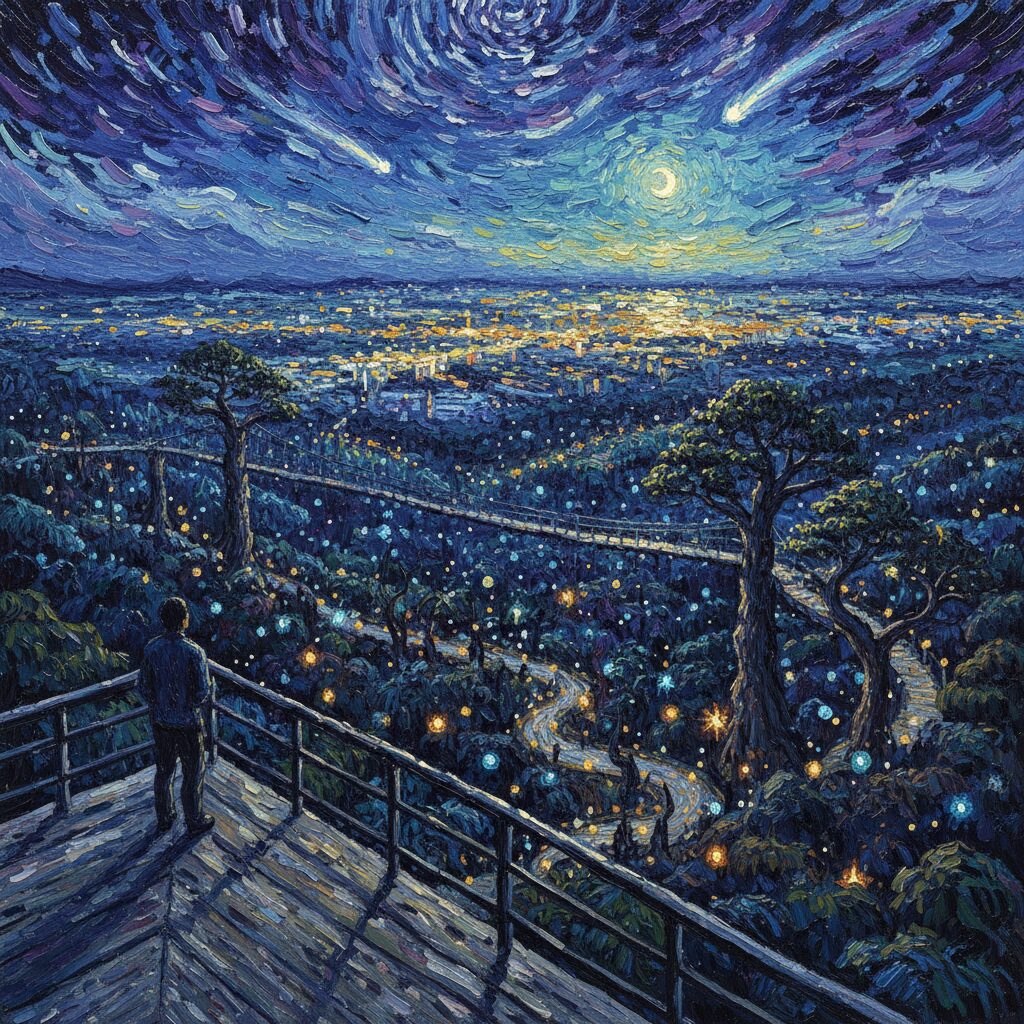
Reaching the far side of the Hoshi no Buranko is not the conclusion of the journey, but rather the start of a fresh perspective. A brief final climb from the bridge’s end brings you to the ‘Yama-biko no Taki’ observation deck. From this vantage point, the view is arguably even more stunning than that from the bridge itself. The observatory offers a sweeping, panoramic view of the entire valley you just crossed. Now, the Hoshi no Buranko serves as the centerpiece of the scene. You can admire its full, graceful arc, a man-made marvel that perfectly complements the surrounding natural beauty. People walking across the bridge appear as small, daring figures on a slender thread, emphasizing the vastness of the landscape. This spot is ideal for capturing that iconic photo of the bridge suspended over the forest. Yet it is also a place for quiet reflection. You can rest on the benches, catch your breath, and simply soak in the grandeur of the Kongo-Ikoma-Kisen Quasi-National Park. The name ‘Yama-biko no Taki’ roughly translates to ‘Mountain Echo Falls’; while there may not be an actual waterfall, the name conveys the spirit of the place—a site where your sense of wonder seems to reverberate from the nearby hills. From the observatory, you face another choice. You may retrace your steps across the bridge, experiencing that exhilarating walk again from a different angle. Or, for the more adventurous, trails continue beyond this point, leading deeper into the mountain range. These less-frequented paths provide a more rugged and solitary hiking experience, offering a chance to fully immerse yourself in the wilderness before looping back toward the park entrance. This network of trails makes Hoshida Enchi a destination worth visiting repeatedly, presenting a new adventure each time, whether you seek a brief, breathtaking thrill or a full day of communion with nature.
A Symphony of Seasons: The Best Time for Your Adventure
Hoshida Park is a destination for every season, each offering its own distinct character and unique beauty. When to visit depends entirely on the experience you desire. Autumn is undoubtedly the highlight. From mid-November to early December, the park bursts into vibrant colors. The Japanese maples, or ‘momiji’, turn brilliant shades of crimson and scarlet, beautifully contrasting with the golden yellows of the ginkgo trees and the deep greens of the cedars. The view from Hoshi no Buranko during this ‘koyo‘ season is world-class, drawing large crowds of nature enthusiasts and photographers. If you come at this peak time, expect company. A weekday visit is highly recommended to avoid weekend crowds, and starting your hike early ensures softer light and greater solitude on the bridge. Spring offers a more delicate, serene charm. Though not a famous cherry blossom spot, sakura trees near the park entrance provide a lovely pink and white welcome in late March and early April. The true wonder of spring, however, is the emergence of ‘shinryoku,’ the fresh, vibrant green leaves. The forest feels alive and renewed, with the air filled with the promise of coming warmth. It’s an ideal time for a peaceful hike, with far fewer visitors than in autumn. Summer brings a welcome respite from Osaka’s intense heat and humidity. The dense forest canopy acts like a natural air conditioner, keeping temperatures inside the park several degrees cooler than the city. The landscape is a deep, uniform green, offering a lush and immersive experience. It’s the perfect season for a leisurely stroll along the shaded river at the park’s base. The only caveat is to be prepared for insects; a good bug spray is essential during the summer months. Winter is a time of quiet reflection. The crowds vanish, and a beautiful stillness settles over the forest. The bare branches of deciduous trees form stark, elegant silhouettes against the sky, revealing views hidden by leaves the rest of the year. The air is crisp and invigorating, and the silence is profound. A winter hike at Hoshida Enchi is a truly meditative experience, offering a chance to connect with the raw, tranquil beauty of the sleeping forest.
A Practical Guide for the Intrepid Traveler

Starting your Hoshida Park adventure is simple, though a bit of planning enhances the experience. The journey itself adds to the fun and is easily manageable as a day trip from anywhere in Osaka, Kyoto, or Nara. Your main route will be via the Keihan Railway. From central Osaka stations like Yodoyabashi or Kyobashi, take the Keihan Main Line to Hirakatashi Station, a major transfer point that’s easy to navigate. At Hirakatashi, switch to the Keihan Katano Line, a quaint local line, and ride it to the last stop, Kisaichi Station. The entire train ride lasts about 45 to 60 minutes. From Kisaichi Station, it’s a pleasant 40-minute walk to the park entrance, with well-marked signs in both Japanese and English, making it difficult to get lost. Simply follow the signs for ‘Hoshida Enchi’ (星の里いわふね). When it comes to attire and what to bring, comfort and practicality are essential. Sturdy walking shoes or hiking boots are a must, as the trails include steep sections, stairs, and uneven terrain. Even on hot days, carrying a light jacket or an extra layer is advisable since it can be cooler under the forest canopy. A small backpack is necessary for water—staying hydrated is vital, especially during the climb—as well as some snacks or a light lunch, since there are no shops or vending machines deep inside the park. In summer, insect repellent and a small towel (‘tenugui’ or ‘oshibori’) to wipe away sweat are very useful, while in autumn and winter, a hat and gloves can make a big difference. Before starting your hike, stop by the Pit-in Hoshida visitor center for your last chance to use modern restrooms and pick up a detailed trail map. The staff is friendly and can provide useful advice on trail conditions. Keep in mind the park’s hours; although the park is generally open, the Hoshi no Buranko suspension bridge operates only from 9:30 AM to 4:30 PM, so plan your hike accordingly to ensure you don’t miss the opportunity to cross it. A half-day is enough for a round trip to the bridge and back at a moderate pace, but allowing a full day gives you time to visit the observatory, enjoy a picnic, and fully appreciate the experience without rushing.
Echoes of the Forest and a Final Glance
Descending from the heights of Hoshida Park, with the image of the Star Swing lingering in your mind, you experience a deep sense of accomplishment and peace. The walk back to Kisaichi Station feels different; you notice more details in the small town, your senses heightened by your time in the forest. You might pause at a local shop for a cold drink or an ice cream, a small treat that tastes infinitely better after a rewarding hike. Leaving Hoshida Enchi is not merely about departing a place but about taking a piece of it with you. It’s the memory of the bridge gently swaying beneath your feet, the panoramic view of endless greenery, and the sound of the wind whispering through the cedar trees. This serves as a powerful reminder of the delicate balance between Japan’s futuristic cities and its deeply cherished natural landscapes. Hoshi no Buranko is more than just an impressive feat of engineering; it stands as a testament to the idea that adventure can be found just around the corner, and that a short journey can bring a spectacular shift in perspective. For any traveler in Osaka seeking to escape the urban hustle for a moment of sublime natural beauty, a day spent walking among the stars at Hoshida Park is an experience that will resonate long after returning to the city lights.
